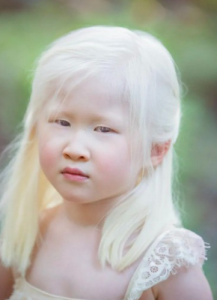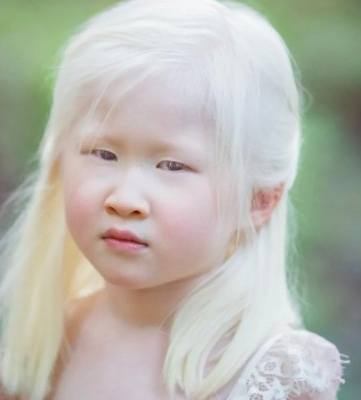The Little Girl of Light: A Story of Abandonment, Courage, and Unconditional Love
On a cool spring morning, the caretaker of a small orphanage on the edge of a quiet town opened the front door to find something she would never forget — a baby girl wrapped in a soft, pale pink blanket. Her skin glowed almost translucent in the morning light, her lashes white as snow, and her eyes a delicate shade of silver-blue. A note was pinned to the blanket. It read only four words: “We can’t raise her.”
That baby, unnamed and unknown, had albinism — a rare genetic condition that affects the body’s production of melanin, giving skin, hair, and eyes a light or white appearance. But to her parents, who were frightened by her unusual look and misunderstood her condition, she seemed different — too different. Fear and social pressure made them walk away.
The Beginning of Her Story
The orphanage workers named her Luna, for she looked like she had been kissed by moonlight. From the first day, Luna drew both attention and tenderness. The nurses noticed that she startled easily under bright lights, her eyes fluttering in discomfort. They quickly learned to dim the lamps and shield her from the harsh sun when they took her outside.
Despite her fragile appearance, Luna was a strong baby — always curious, always listening. The caretakers began to realize that her condition didn’t define her; it was simply part of who she was. Within a few weeks, Luna had become the quiet heart of the orphanage.
The Stigma of Difference
In many parts of the world, albinism is misunderstood. Myths and superstitions sometimes follow children like Luna. In some communities, people wrongly believe that albinism is a curse or a punishment. Others see those with it as symbols of bad luck. This fear often isolates families and leads to heartbreaking decisions, like the one her parents made.
But science tells a different story. Albinism simply means that the body doesn’t produce enough pigment. It doesn’t affect a person’s intelligence or their ability to love and be loved. The real struggle lies not in the condition itself, but in how society reacts to it.
The orphanage staff knew this. They made it their mission to protect Luna not only from the sunlight but from prejudice.
A Glimpse of Hope
When Luna turned two, she began to blossom. Her hair shimmered like silk in the sunlight, and her laughter filled the orphanage halls. Yet when potential adoptive parents visited, many hesitated. They would smile politely, then look away when they noticed her unusual coloring.
“She’s beautiful,” one woman whispered once, “but she might have… problems.”
Each rejection left the caregivers disheartened, but Luna seemed unaware of the judgments. She built towers of blocks, danced to nursery rhymes, and hugged every visitor who walked through the door. It was as if she instinctively knew that her purpose was to bring light where others saw darkness.
The Family That Saw Beyond
One afternoon, a couple named Mara and Julian came to the orphanage. They had struggled for years with infertility and had decided to open their hearts to adoption. As they toured the rooms, Mara noticed a small figure sitting alone by the window, arranging shells in a perfect circle.
The child looked up, her pale eyes catching the afternoon sun, and smiled — the kind of smile that could soften even the hardest heart.
“She’s the one,” Mara whispered.
The director hesitated. “Her name is Luna. She has albinism. It requires some care — sun protection, regular eye check-ups…”
But before she could finish, Julian smiled. “Then we’ll learn everything we need to.”
And just like that, Luna’s story began to change.
Learning to Live in the Light
The first months in her new home were filled with adjustments. The couple researched how to protect her delicate skin, installing special window films to block UV rays and buying wide-brimmed hats for every season. They read bedtime stories about courage and difference, teaching Luna that being unique was not a flaw but a gift.
When she started preschool, other children asked questions. “Why is your hair white? Why do you wear big sunglasses?”
Luna, never shy, would grin and answer, “Because I’m part moonlight!” Her teachers couldn’t help but smile.
Yet there were hard days too. Some children teased her, calling her a “ghost.” Once, a teacher had to comfort her when she came home crying, asking, “Mommy, why don’t I look like the other kids?”
Mara knelt beside her and said softly, “Because you were born to remind people what light really looks like.”
Growing Beyond the Pain
As Luna grew older, she became a quiet advocate for acceptance. In middle school, she wrote a short essay titled “The Color of Courage.” In it, she described how she once thought her skin made her invisible — until she realized it made her stand out for a reason. Her words touched her classmates so deeply that her teacher asked to publish it in the school paper.
Soon, Luna’s story began to spread. Local organizations invited her to speak about inclusion and kindness. She was still just a child, but her message carried weight: “People fear what they don’t understand. But if they looked twice, they’d see the beauty in the light.”
The Power of Love
Years later, when Luna was asked about her beginnings — the note, the abandonment, the orphanage — she didn’t speak with bitterness. “They didn’t know,” she said simply. “They were afraid. But fear isn’t the end of a story. It’s where love begins to rewrite it.”
Her parents, Mara and Julian, had taught her that truth. They never hid her past, nor did they let it define her. They told her she had been chosen twice — first by life, then by love.
A Symbol of Acceptance
By her late teens, Luna had become an artist. She painted luminous portraits full of white and gold hues — reflections of her world, where light and shadow danced in harmony. Her artwork began to appear in local galleries, often accompanied by her quote: “We are all made of light, just in different shades.”
One of her paintings, titled The Doorstep, depicted a small bundle beneath a rising sun. It was her way of forgiving the beginning that once broke her.
When asked what she hoped people would feel when they saw her work, Luna said, “I want them to understand that beauty isn’t always what we expect. Sometimes it’s the thing we were afraid to look at.”
Full Circle
The orphanage that once sheltered her kept a framed photograph of Luna and her family near the entrance. The director often pointed to it when new babies arrived, saying, “See that girl? She started her life right here. And look where love took her.”
Luna would sometimes visit, bringing toys and sunscreen for the children. She’d kneel beside cribs and whisper softly, “You’re already perfect. Someone just hasn’t seen it yet.”
Epilogue: The Lesson of Luna
Luna’s story reminds us that difference is never a reason to turn away. Fear can make people do cruel things, but compassion can heal those wounds. Every child — regardless of how they look — deserves not pity, but possibility.
The baby once left on an orphanage doorstep didn’t just survive; she became a symbol of hope. Her life teaches that the light we carry inside can outshine even the darkest misunderstanding.
And somewhere, perhaps under a moonlit sky, the parents who once left her might look up and whisper her name — the name that means “light” — and finally understand what they lost, and what the world gained.


